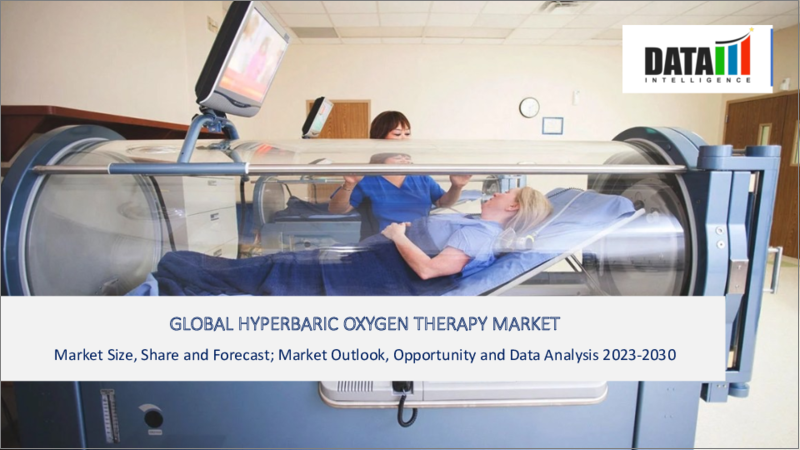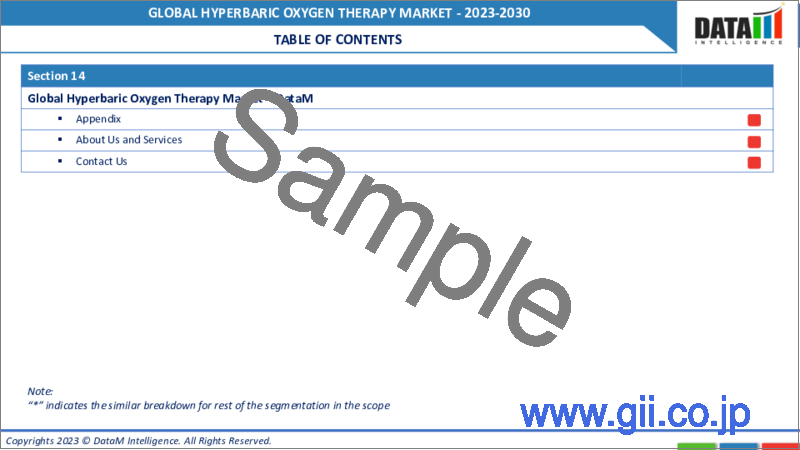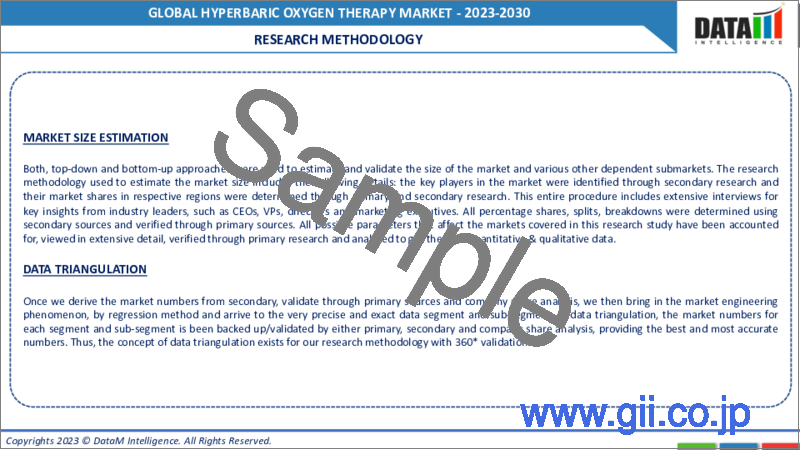|
|
市場調査レポート
商品コード
1304546
高気圧酸素療法の世界市場-2023年~2030年Global Hyperbaric Oxygen Therapy Market - 2023-2030 |
||||||
カスタマイズ可能
適宜更新あり
|
|||||||
| 高気圧酸素療法の世界市場-2023年~2030年 |
|
出版日: 2023年07月07日
発行: DataM Intelligence
ページ情報: 英文 195 Pages
納期: 即日から翌営業日
|
- 全表示
- 概要
- 目次
市場概要
高気圧酸素療法の世界市場規模は2022年に32億米ドルに達し、2030年には67億米ドルに達すると成長が予測されています。世界の高気圧酸素療法市場は、予測期間中(2023~2030年)に9.9%のCAGRを示すと予測されています。技術的進歩の増加と新規製品への投資の拡大が、高気圧酸素療法市場の動向の需要を押し上げています。
動脈ガス塞栓症や減圧症の唯一の治療法として認められているのがHBOTです。ボイルの法則で予測されるように、HBOTの圧縮段階とも呼ばれる加圧時には、体内の気体を含む空洞に収縮が起こり、気泡を減少させて組織や血管内領域の圧力を緩和するのに役立ちます。新製品の発売と創傷治癒の普及率の上昇が、高気圧酸素療法の世界市場を推進している主な要因です。
高気圧酸素療法市場の範囲は、糖尿病性足潰瘍、創傷治癒、減圧症、感染症治療、ガス塞栓症などの用途で構成され、高気圧酸素療法市場シェアを拡大しています。高気圧酸素療法の世界市場は、研究開発の増加や各国での新規製品承認などの要因により拡大しており、高気圧酸素療法市場の成長にも明るい展望が生まれています。
市場力学
技術の進歩と利点の増加が高気圧酸素療法市場の成長を牽引
高気圧酸素療法では、肺胞-血漿勾配と酸素溶解度を高めるために、それぞれダルトンの法則とヘンリーの法則が利用されています。これを数学的に説明すると、3ATAで100%酸素を投与すると、組織と動脈の酸素濃度がそれぞれ500mmHgと2000mmHg上昇し、6mL O2/dLの供給が可能になります。
明らかに、HBOT後、血漿の溶存酸素運搬能力は、ヘモグロビンの助けなしに恒常性を維持するのに十分です。その結果、一酸化炭素中毒や重度の貧血のように、ヘモグロビンによる酸素運搬が阻害されている状態でも、酸素を組織に運搬することができます。
ヘモグロビンよりも血漿を酸素運搬に用いるもう一つの利点は、物理的な障害(血栓や閉塞など)のために赤血球が到達できない場所にも到達できることです。こうした利点は、高気圧酸素療法市場の成長を促進する大きな要因です。
主な企業による研究開発と戦略的パートナーシップの拡大がメーカーに有利な機会を生み出す
高気圧酸素の潜在的な臨床効果は、さまざまな場面で研究されています。老衰と脳卒中が研究対象です。また、スポーツ外傷、高山病、脳損傷、認知機能、片頭痛、劇症肝炎、脊髄損傷、閉鎖性頭部損傷、鎌状赤血球症などの調査も行われています。
また、世界中の多施設共同研究において、劇症紫斑病、放線菌症、腸間膜血栓症、網膜中心動脈閉塞症、嚢胞様黄斑浮腫、ハンセン病などの研究が行われています。無作為化臨床試験のデザイン、プラセボ効果、ホーソン効果、薬物動態学、その他のトピックについても議論されています。
在院日数の短縮や罹病期間の短縮により、従来の治療に高気圧酸素を加えることで大幅なコスト削減が可能であることがコスト分析で実証されています。さまざまな調査が行われています。
高気圧酸素療法に伴う限界は市場の成長を妨げます
あらゆる医療処置と同様に、治療にも利点と欠点があります。高濃度の酸素は酸化ストレスにつながり、DNAを含む細胞や組織を損傷する可能性があります。これは突然変異を引き起こす可能性があるため、損傷が十分に治癒されない場合、がんを引き起こす可能性があります。しかし、科学文献を調べてみると、このような心配にもかかわらず、発表された研究の大半はそのような影響を発見できていないことがわかっています。
急激な圧力の変化は、中耳、頭蓋洞、あるいは(まれに)歯や肺を破裂させ、患者に軽度から重度の痛みを引き起こすことがあります。自動膨張法のようなリスク軽減法について患者を教育することで、これを防ぐことができます。HBOTが治療できる病気や障害の範囲が広がっているにもかかわらず、米国ではまだいくつかの制限があります。
典型的な90分のセッションは300~400ドルで、HBOTはかなり高価です。したがって、30~40回のセッションの価格は9,000~16,000ドルになります。しかし、病院内での非高圧酸素療法と比較すると、骨壊死患者に対する高気圧酸素療法の経済分析では、96,000ドルの節約になることが明らかになっています。
COVID-19影響分析
COVID-19の流行と世界の封鎖は、あらゆる業界の企業の財務の健全性に影響を及ぼしています。その結果、米国食品医薬品局(FDA)は、COVID-19健康緊急事態の期間中、スポンサーと研究者を支援し、試験参加者の安全を確保し、適正臨床実施(GCP)に従い、試験の完全性に対するリスクを低減するための一般的な配慮を含むガイドラインを発表しました。
ロシア・ウクライナ紛争影響分析
ロシア・ウクライナ紛争は、この地域の主要市場プレーヤーの数が少ないため、世界の高気圧酸素療法市場への影響は低いと推定されます。しかし、原材料の輸出入の影響は、予測期間中、世界の高気圧酸素治療市場の成長にほとんど影響を与えないと予想されます。
目次
第1章 調査手法と調査範囲
第2章 定義と概要
第3章 エグゼクティブサマリー
第4章 市場力学
- 影響要因
- 促進要因
- 技術的進歩の高まりと規制当局の承認
- 急性・慢性創傷の増加
- 抑制要因
- 高気圧酸素療法に伴う合併症
- 機会
- 研究開発と新製品の上市の増加
- 影響分析
- 促進要因
第5章 産業分析
- ポーターの5フォース分析
- サプライチェーン分析
- 価格分析
- 規制分析
第6章 COVID-19分析
第7章 製品タイプ別
- マルチスペースチャンバー
- ポータブルチャンバー
- 単置型チャンバー
- その他
第8章 用途別
- 糖尿病性足潰瘍
- 創傷治癒
- 減圧症
- 感染症治療
- ガス塞栓症
- その他
第9章 エンドユーザー別
- 病院
- 在宅医療
- その他
第10章 地域別
- 北米
- 米国
- カナダ
- メキシコ
- 欧州
- ドイツ
- 英国
- フランス
- スペイン
- イタリア
- その他欧州
- 南米
- ブラジル
- アルゼンチン
- その他南米
- アジア太平洋
- 中国
- インド
- 日本
- その他アジア太平洋地域
- 中東およびアフリカ
- 主な地域別ダイナミクス
第11章 競合情勢
- 競合シナリオ
- 市況/シェア分析
- M&A分析
第12章 企業プロファイル
- Environmental Tectonics Corporation
- 会社概要
- 製品ポートフォリオと説明
- 財務概要
- 主な発展
- HEARMEC
- Sosgroup
- Gulf Coast Hyperbarics Inc.
- Perry Baromedical
- Tekna Hyperbaric
- Hpotech Hyperbaric Solutions
- Sechrist Industries, Inc
- Haux Life Support
- Royal IHC
第13章 付録
Market Overview
The Global Hyperbaric Oxygen Therapy Market size reached US$ 3.2 billion in 2022 and is projected to witness lucrative growth by reaching up to US$ 6.7 billion by 2030. The global hyperbaric oxygen therapy market is expected to exhibit a CAGR of 9.9% during the forecast period (2023-2030). The increasing technological advancements and the growing investments in novel products are driving up demand for hyperbaric oxygen therapy market trends.
The only accepted treatment for arterial gas embolism and decompression sickness is HBOT. As predicted by Boyle's law, a contraction takes place in the body's gas-containing cavities during pressurization, also referred to as the compression phase of HBOT, which aids in reducing air bubbles and relieving pressure in the tissue or intravascular area. The launch of new products and an increase in the prevalence of wound healing are the main factors propelling the global market for hyperbaric oxygen therapy.
The hyperbaric oxygen therapy market scope comprises applications such as diabetic foot ulcers, wound healing, decompression sickness, infection treatment, gas embolism and others, which has increased the hyperbaric oxygen therapy market share. The global market for hyperbaric oxygen therapy is expanding as a result of factors including increasing research and development and their upcoming novel product approvals across countries are also creating a positive outlook for the hyperbaric oxygen therapy market growth.
Market Dynamics
Rising Technological Advancements and Advantages Drive the Growth of the Hyperbaric Oxygen Therapy Market
Dalton's law and Henry's law are both utilized by hyperbaric oxygen therapy to boost the alveoli-plasma gradient and oxygen solubility, respectively. To illustrate this mathematically, giving 100% oxygen at 3 ATA raises tissue and arterial oxygen tension by 500 and 2000 mmHg, respectively, allowing for the delivery of 6 mL O2/dL.
Evidently, after HBOT, the plasma's ability to carry dissolved oxygen is sufficient to sustain homeostasis without the aid of hemoglobin. As a result, even in conditions where hemoglobin oxygen transport is impeded, like carbon monoxide poisoning and severe anemia, this oxygen can still be delivered to tissues.
Another benefit of employing plasma to deliver oxygen over hemoglobin is that it can get to places where red blood cells can't because of physical obstructions (such clots or occlusions). These advantages are the major factor that will help in driving the growth of the hyperbaric oxygen therapy market.
Rising Research and Development and Strategic Partnerships by Key Companies creates Lucrative Opportunities for Manufacturers
The potential clinical benefits of hyperbaric oxygen are being investigated in a number of different contexts. Investigated are senility and strokes. Research is also being done on sports injuries, high altitude sickness, brain injuries, cognitive functions, migraines, fulminant hepatitis, Spinal cord injury, closed head injury, and sickle cell crisis.
Workers in multicentric studies around the world are also investigating purpura fulminans, actinomycosis, mesenteric, thrombosis, central retinal artery occlusion, cystoid macular edema, and leprosy. Randomized clinical trial designs, the placebo effect, the Hawthorne effect, pharmacokinetics, and other topics are also being discussed.
Due to shorter hospital stays and shorter illness duration, cost analysis has demonstrated that adding hyperbaric oxygen to conventional treatment yields significant cost savings. Various kinds of research are being done.
Limitations Associated with Hyperbaric Oxygen Therapy will Hamper the Growth of the Market.
Similar to every medical procedure, treatment has advantages and disadvantages. High oxygen concentrations can lead to oxidative stress, which can damage cells and tissues, including DNA. This has the potential to cause cancer if the damage is not sufficiently healed since it can result in mutations. An examination of the scientific literature, however, revealed that, in spite of this worry, the vast majority of published investigations had failed to find such an effect.
Rapid pressure shifts can cause the middle ear, cranial sinuses, or (rarely) the teeth or lungs to rupture, causing mild to severe pain in the patient. By educating the patient about risk reduction techniques like the auto inflation technique, this can be prevented. Despite the expanding range of illnesses and disorders that HBOT can treat, there are still some restrictions in place in the United States.
With a typical 90-minute session ranging between $300 and $400, HBOT is rather pricey. Therefore, the price of 30-40 sessions can range from $9,000-16,000. However, compared to in-hospital, nonhyperbaric oxygen therapy, an economic analysis of hyperbaric oxygen therapy for individuals with osteoradionecrosis revealed a savings of $96,000.
COVID-19 Impact Analysis
The COVID-19 epidemic and the worldwide lockdown have had an effect on the financial health of businesses in all industries. As a result, the U.S. Food and Drug Administration (FDA) released guidelines for the duration of the COVID-19 health emergency that include general considerations to assist sponsors and researchers, ensure trial participants' safety, follow good clinical practice (GCP), and reduce risks to trial integrity.
Russia-Ukraine War Impact Analysis
The Russia-Ukraine conflict is estimated to have a low impact on the global hyperbaric oxygen therapy market, owing to the low number of key market players in this region. However, the impact of the import and export of raw materials is expected to have little influence over the global hyperbaric oxygen therapy market growth over the forecast period.
Segment Analysis
The global hyperbaric oxygen therapy market is segmented based on product type, application, end user and region.
Wound Healing from the Application Segment Accounts for 36.8% of the Market Share Owing to Rising Research
Hemostasis, the elimination of infectious agents, the resolution of the inflammatory response, the development of a connective tissue matrix, and resurfacing are all stages of the normal wound healing process, which is a positive feedback system. Chronic wounds are ones that do not fully heal as a result of an internal or external issue that arises throughout one or more stages of the healing process.
These include arterial ulcers, pressure ulcers, venous stasis ulcers, and diabetic wounds. The most frequent causes of wound healing delays are infection and ischemia, both of which are characterized by hypoxia. The infection triggers an overly aggressive response during the inflammatory stage of wound healing, which leads to a quick loss of oxygen in the tissue and inadequate blood flow because of edema.
By boosting the blood's oxygen content and creating a conducive gradient for oxygen diffusion into the injured tissues, hyperbaric oxygen therapy promotes the healing process. Since fibroblast proliferation, angiogenesis, collagen synthesis, and infection resistance are oxygen-dependent activities, enough oxygen is crucial for healing. HBOT has also been demonstrated to control inflammation by generating reactive oxygen species.
Geographical Analysis
North America Accounted for Approximately 39.5% of the Market Share Owing to the Strong Presence of Major Players and The Advantages and Advancements in NGS
Manufacturers have chances to expand their operations in this region because of the rising demand for hyperbaric oxygen therapy for advancements in North America. The area has many producers and suppliers, and its rapid economic development has raised the industrial production of hyperbaric oxygen chambers, which has increased the demand.
There are many manufacturers and suppliers in North America, and as a result of the region's rapid economic growth, industrial production has expanded, feeding the desire for research and development of novel products.
The market will grow as new technology for research and development emerge. Rising technological developments, governmental approvals, and the introduction of new products all contribute to growth. People are becoming more aware of novel wound healing therapies or chambers, leading to the expansion of the market in this region. These factors are responsible for dominance of North America.
Competitive Landscape
The major global players in the hyperbaric oxygen therapy market include: Environmental Tectonics Corporation, Sosgroup, HEARMEC, Gulf Coast Hyperbarics Inc., Tekna Hyperbaric, Perry Baromedical, Hpotech Hyperbaric Solutions, Haux Life Support, Sechrist Industries, Inc and Royal IHC among others.
Why Purchase the Report?
- To visualize the global hyperbaric oxygen therapy market segmentation based on product type, application, end user and region, as well as understand key commercial assets and players.
- Identify commercial opportunities by analyzing trends and co-development.
- Excel data sheet with numerous data points of hyperbaric oxygen therapy market-level with all segments.
- PDF report consists of a comprehensive analysis after exhaustive qualitative interviews and an in-depth study.
- Product mapping available as Excel consisting of key products of all the major players.
The global hyperbaric oxygen therapy market report would provide approximately 53 tables, 54 figures and 195 Pages.
Target Audience 2023
- Manufacturers/ Buyers
- Industry Investors/Investment Bankers
- Research Professionals
- Emerging Companies
Table of Contents
1. Methodology and Scope
- 1.1. Research Methodology
- 1.2. Research Objective and Scope of the Report
2. Definition and Overview
3. Executive Summary
- 3.1. Snippet by Product Type
- 3.2. Snippet by Application
- 3.3. Snippet by End User
- 3.4. Snippet by Region
4. Dynamics
- 4.1. Impacting Factors
- 4.1.1. Drivers
- 4.1.1.1. Rising Technological Advancements and Regulatory Approvals
- 4.1.1.2. Increasing Prevalence of Acute and Chronic Wounds
- 4.1.2. Restraints
- 4.1.2.1. Complications Associated with Hyperbaric Oxygen Therapy
- 4.1.3. Opportunity
- 4.1.3.1. Rising Research and Development and Novel Product Launches
- 4.1.4. Impact Analysis
- 4.1.1. Drivers
5. Industry Analysis
- 5.1. Porter's 5 Forces Analysis
- 5.2. Supply Chain Analysis
- 5.3. Pricing Analysis
- 5.4. Regulatory Analysis
6. COVID-19 Analysis
- 6.1. Analysis of COVID-19
- 6.1.1. Scenario Before COVID-19
- 6.1.2. Scenario During COVID-19
- 6.1.3. Scenario Post COVID-19
- 6.2. Pricing Dynamics Amid COVID-19
- 6.3. Demand-Supply Spectrum
- 6.4. Government Initiatives Related to the Market During Pandemic
- 6.5. Manufacturers Strategic Initiatives
- 6.6. Conclusion
7. By Product Type
- 7.1. Introduction
- 7.1.1. Market Size Analysis and Y-o-Y Growth Analysis (%), By Product Type
- 7.1.2. Market Attractiveness Index, By Product Type
- 7.2. Multiplace Chambers*
- 7.2.1. Introduction
- 7.2.2. Market Size Analysis and Y-o-Y Growth Analysis (%)
- 7.3. Portable Chambers
- 7.4. Monoplace Chambers
- 7.5. Others
8. By Application
- 8.1. Introduction
- 8.1.1. Market Size Analysis and Y-o-Y Growth Analysis (%), By Application
- 8.1.2. Market Attractiveness Index, By Application
- 8.2. Diabetic Foot Ulcers *
- 8.2.1. Introduction
- 8.2.2. Market Size Analysis and Y-o-Y Growth Analysis (%)
- 8.3. Wound Healing
- 8.4. Decompression Sickness
- 8.5. Infection Treatment
- 8.6. Gas Embolism
- 8.7. Others
9. By End User
- 9.1. Introduction
- 9.1.1. Market Size Analysis and Y-o-Y Growth Analysis (%), By End User
- 9.1.2. Market Attractiveness Index, By End User
- 9.2. Hospitals *
- 9.2.1. Introduction
- 9.2.2. Market Size Analysis and Y-o-Y Growth Analysis (%)
- 9.3. Home care settings
- 9.4. Others
10. By Region
- 10.1. Introduction
- 10.1.1. Market Size Analysis and Y-o-Y Growth Analysis (%), By Region
- 10.1.2. Market Attractiveness Index, By Region
- 10.2. North America
- 10.2.1. Introduction
- 10.2.2. Key Region-Specific Dynamics
- 10.2.3. Market Size Analysis and Y-o-Y Growth Analysis (%), By Product Type
- 10.2.4. Market Size Analysis and Y-o-Y Growth Analysis (%), By Application
- 10.2.5. Market Size Analysis and Y-o-Y Growth Analysis (%), By End User
- 10.2.6. Market Size Analysis and Y-o-Y Growth Analysis (%), By Country
- 10.2.6.1. The U.S.
- 10.2.6.2. Canada
- 10.2.6.3. Mexico
- 10.3. Europe
- 10.3.1. Introduction
- 10.3.2. Key Region-Specific Dynamics
- 10.3.3. Market Size Analysis and Y-o-Y Growth Analysis (%), By Product Type
- 10.3.4. Market Size Analysis and Y-o-Y Growth Analysis (%), By Application
- 10.3.5. Market Size Analysis and Y-o-Y Growth Analysis (%), By End User
- 10.3.6. Market Size Analysis and Y-o-Y Growth Analysis (%), By Country
- 10.3.6.1. Germany
- 10.3.6.2. The U.K.
- 10.3.6.3. France
- 10.3.6.4. Spain
- 10.3.6.5. Italy
- 10.3.6.6. Rest of Europe
- 10.4. South America
- 10.4.1. Introduction
- 10.4.2. Key Region-Specific Dynamics
- 10.4.3. Market Size Analysis and Y-o-Y Growth Analysis (%), By Product Type
- 10.4.4. Market Size Analysis and Y-o-Y Growth Analysis (%), By Application
- 10.4.5. Market Size Analysis and Y-o-Y Growth Analysis (%), By End User
- 10.4.6. Market Size Analysis and Y-o-Y Growth Analysis (%), By Country
- 10.4.6.1. Brazil
- 10.4.6.2. Argentina
- 10.4.6.3. Rest of South America
- 10.5. Asia-Pacific
- 10.5.1. Introduction
- 10.5.2. Key Region-Specific Dynamics
- 10.5.3. Market Size Analysis and Y-o-Y Growth Analysis (%), By Product Type
- 10.5.4. Market Size Analysis and Y-o-Y Growth Analysis (%), By Application
- 10.5.5. Market Size Analysis and Y-o-Y Growth Analysis (%), By End User
- 10.5.6. Market Size Analysis and Y-o-Y Growth Analysis (%), By Country
- 10.5.6.1. China
- 10.5.6.2. India
- 10.5.6.3. Japan
Australia
- 10.5.6.4. Rest of Asia-Pacific
- 10.6. Middle East and Africa
- 10.6.1. Introduction
- 10.6.2. Key Region-Specific Dynamics
- 10.6.3. Market Size Analysis and Y-o-Y Growth Analysis (%), By Product Type
- 10.6.4. Market Size Analysis and Y-o-Y Growth Analysis (%), By Application
- 10.6.5. Market Size Analysis and Y-o-Y Growth Analysis (%), By End User
11. Competitive Landscape
- 11.1. Competitive Scenario
- 11.2. Market Positioning/Share Analysis
- 11.3. Mergers and Acquisitions Analysis
12. Company Profiles
- 12.1. Environmental Tectonics Corporation *
- 12.1.1. Company Overview
- 12.1.2. Product Portfolio and Description
- 12.1.3. Financial Overview
- 12.1.4. Key Developments
- 12.2. HEARMEC
- 12.3. Sosgroup
- 12.4. Gulf Coast Hyperbarics Inc.
- 12.5. Perry Baromedical
- 12.6. Tekna Hyperbaric
- 12.7. Hpotech Hyperbaric Solutions
- 12.8. Sechrist Industries, Inc
- 12.9. Haux Life Support
- 12.10. Royal IHC
LIST NOT EXHAUSTIVE
13. Appendix
- 13.1. About Us and Services
- 13.2. Contact Us






